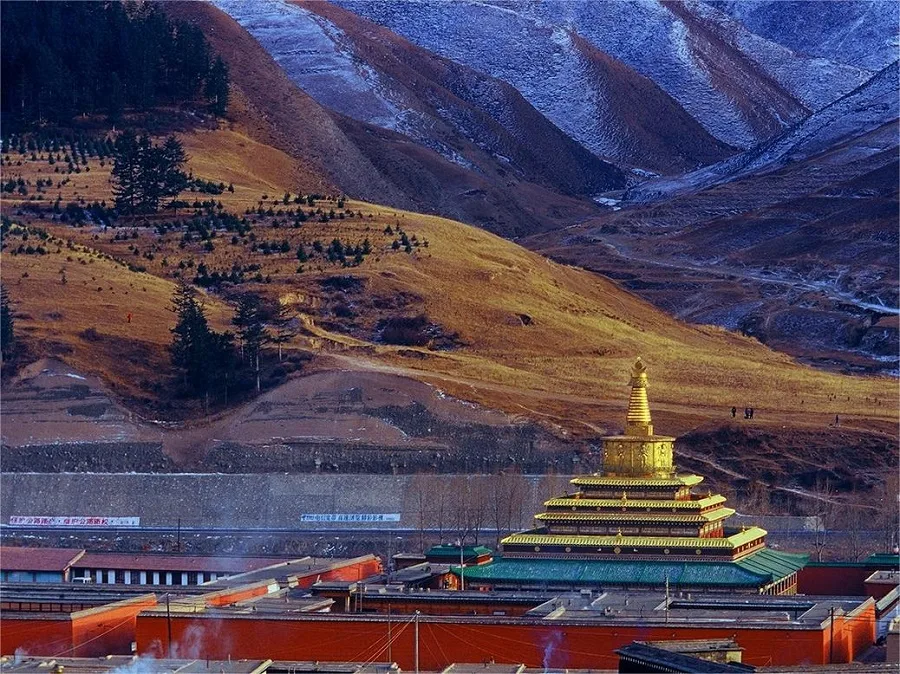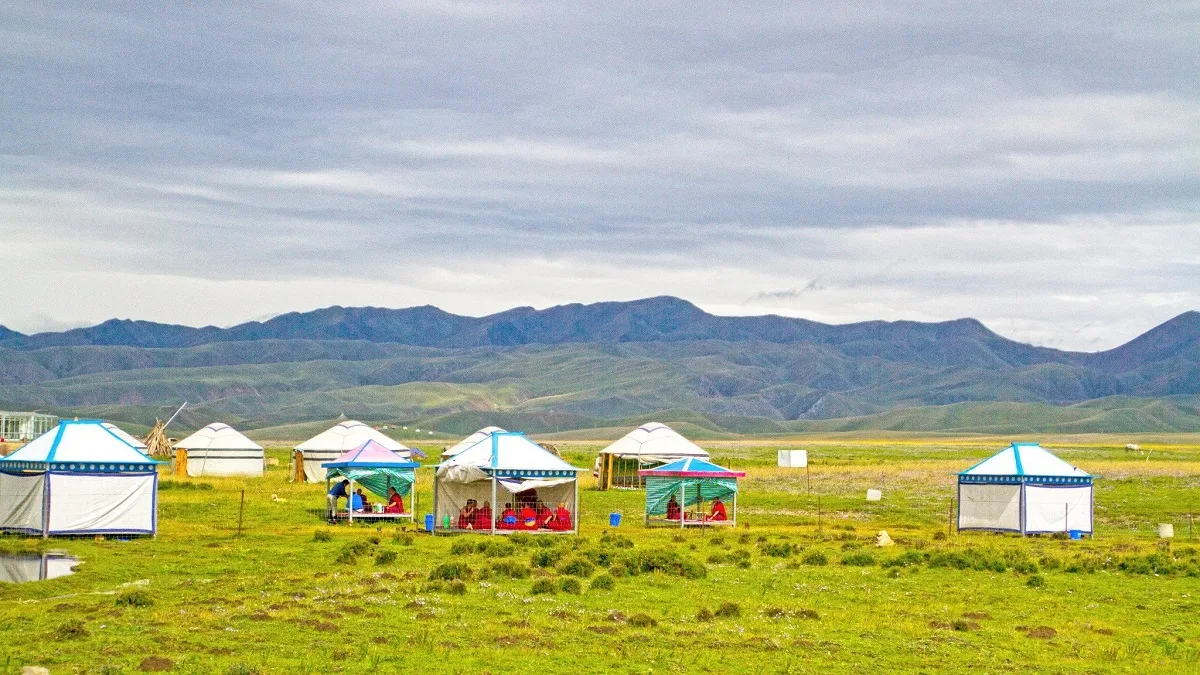Sangke Grassland (桑科草原), located in Gannan Tibetan Autonomous Prefecture of Gansu Province, is a vast meadow grassland with an average elevation of over 3,000 meters and spanning an area of 70 square kilometers. It is one of the primary livestock bases in Gannan. The grassland is renowned for its historical significance as the site where the legendary King Gesar held his smoke offering ceremonies and horse races to establish his kingship. In Tibetan, smoke offering is called “Sanghuo,” and the act of performing it is “Weisang,” hence the name Sangke.
With a sparse population of just over 4,000 herders, Sangke Grassland is a precious natural tourism destination. Despite its vastness, the area remains unspoiled and provides an authentic glimpse into the traditional Tibetan lifestyle. There are two Tibetan-style tent reception centers that operate from July to September, offering fresh yak butter tea, tsampa (roasted barley flour), Tibetan buns, and hand-pulled mutton, among other local delicacies. Additionally, visitors can enjoy horseback riding, yak rides, archery, and bonfire parties, immersing themselves in the unique and rustic Tibetan culture.
The grassland is famous for its horse racing festival, held annually on the 13th day of the seventh lunar month. During this event, herders from the seven major tribes of Sangke gather for a grand horse race. The festival attracts numerous visitors and herders from various regions, filling the grassland with a sea of tents and creating a vibrant and lively atmosphere.
Table of Contents
- Basic Information
- Location and Transportation
- Highlights of Sangke Grassland
- Vlog about Sangke Grassland
- Useful Tips about Visiting Sangke Grassland
- Other Attractions in Xiahe County
Basic Information
| Estimated Length of Tour | 2 – 3 hours |
| Ticket Price | Free |
| Opening Hours | 24 hours a day throughout the year |
| Best Time to Visit | July – September |
Location and Transportation
Sangke Grassland is located in Xiahe County, Gannan Tibetan Autonomous Prefecture, Gansu Province, China. It lies 18 kilometers southwest of the county seat of Xiahe, with a direct road leading to it. Visitors can reach Sangke Grassland easily after visiting the nearby Labrang Monastery, as it is just a 15-minute drive away. Alternatively, one can rent a bicycle in Xiahe to ride to the grassland for a more scenic and immersive experience.
For those traveling from Lanzhou, the capital of Gansu Province, buses are available to Xiahe, costing approximately 75 yuan. Once in Xiahe, visitors can take a taxi to Sangke Grassland for about 25 yuan.
Highlights of Sangke Grassland
Labrang Monastery

Located just 1 kilometer west of Xiahe County on the banks of the Daxia River, Labrang Monastery is a renowned Tibetan Buddhist monastery belonging to the Gelug sect (Yellow Hat sect). It is one of the six great monasteries of the Gelug school and once served as the political, religious, and cultural center for Tibetans in the bordering regions of Gansu, Qinghai, and Sichuan. The name “Labrang” translates to “place of the Buddhist palace” in Tibetan.
The monastery covers an area of 8.2 hectares with a built-up area of 823,000 square meters. It was founded in 1709 during the 48th year of the Kangxi Emperor’s reign in the Qing Dynasty. Key structures within the monastery include the Grand Sutra Hall (Wensi Institute), Lower Tantric Institute, Upper Tantric Institute, Wheel of Time Institute, Medical Institute, and the Institute of Esoteric Buddhism. Additionally, there are 18 living Buddha residences, 18 assembly halls, numerous stupas, debating courtyards, scripture libraries, and printing houses. The architectural layout is meticulously planned, with grand and magnificent buildings that reflect the unique Tibetan style.
Xianglang Festival

The Xianglang Festival is a traditional event celebrated by the Tibetans on Sangke Grassland. The word “Xianglang” translates to “collecting firewood” in Tibetan. Every June, when the grassland is in full bloom and the air is filled with the fragrance of milk and meat, monks from the monastery would use the pretext of collecting firewood to spend a few days in the outdoors with their families. Over time, this practice evolved into the Xianglang Festival.
On the morning of the festival’s eve, people dress in their finest attire and joyfully gather at Labuzai Hill, a sacred site for worshipping deities. They fire guns, set off fireworks, and chant loudly to celebrate. The day begins with smoke offerings (Weisang) to the gods, seeking blessings for a bountiful harvest and the well-being of their livestock. Following the rituals, a variety of recreational activities commence, including horse racing, yak racing, wrestling, and tug-of-war. People of all ages actively participate in these events, creating a lively and festive atmosphere.
As night falls, the festival continues with the Tibetans showcasing their singing and dancing talents around a large bonfire. The melodious songs and graceful dances highlight the rich cultural heritage and vibrant community spirit of the Tibetan people.
Vlog about Sangke Grassland
Useful Tips about Visiting Sangke Grassland
A visit to Sangke Grassland is often combined with a trip to Labrang Monastery, utilizing any extra time available. Visitors can take a small car from Xiahe County or rent a bicycle for a leisurely ride to the grassland, both of which offer convenient transportation options. The typical duration for exploring Sangke Grassland is around 3-4 hours, after which visitors usually return to Xiahe County for lodging.
For those who wish to extend their stay, overnight accommodation on the grassland is also an option. The grassland offers homestays that provide horseback riding, traditional Tibetan meals, and lodging services. Accommodation typically includes tents or traditional Tibetan-style rooms, which may have basic amenities but offer an authentic cultural experience.
Spending the night on the grassland is especially appealing for photography enthusiasts, as the clear, unpolluted skies provide stunning opportunities for star-gazing and capturing night skies.





The grass on the Sangke Prairie has just started to sprout a bit of green, giving it an overall yellow-green appearance. It’s less than a thirty-minute drive from Labuleng Temple to the Sangke Prairie. The scenery along the way is nice, and encountering a herd of sheep crossing the road was quite amusing.
The Sangke Prairie is truly unforgettable! It was so beautiful that it felt more like a dream.
Before you go, make sure to check the weather forecast. It was too cold, and the sky was overcast, which made the photos not look as good.
The winter pasture of the Sangke Prairie! I unexpectedly saw wild yaks, marmots, and vultures.
At the Sangke Prairie, we avoided the crowded areas. Starting from the restroom at the wetland viewing area, we walked a few dozen meters ahead. On the left, there was a stretch of asphalt road that transitioned into an unpaved path, leading us to a grassland marked only by the tracks of vehicles. We reached a vast grassland that felt like it belonged to just us. Our group of 15 climbed to the top of the mountain, and it was… Read more »
The Sangke Grasslands are incredibly beautiful.
I visited in autumn and experienced the stunning transition of colors on the grasslands as the seasons changed.
The local people are both warm and friendly.
It’s very convenient to take a taxi from Labrang Monastery to get there.
Along the way, you can see the vast expanse of grasslands through the window.
You can ride horses at the stables along the Sangke Grassland. There are both large and small circles available, with prices ranging from 50 to 100 yuan. Don’t forget to bargain; it’s definitely worth it!
A slow ride on the small circle costs 30 yuan (suitable for complete beginners).
A fast ride on the small circle costs 50 yuan (suitable for slightly braver beginners).
In Gannan during October 1st, it’s already necessary to wear a thin down jacket and a fleece-lined windbreaker, as it has started to snow from time to time.